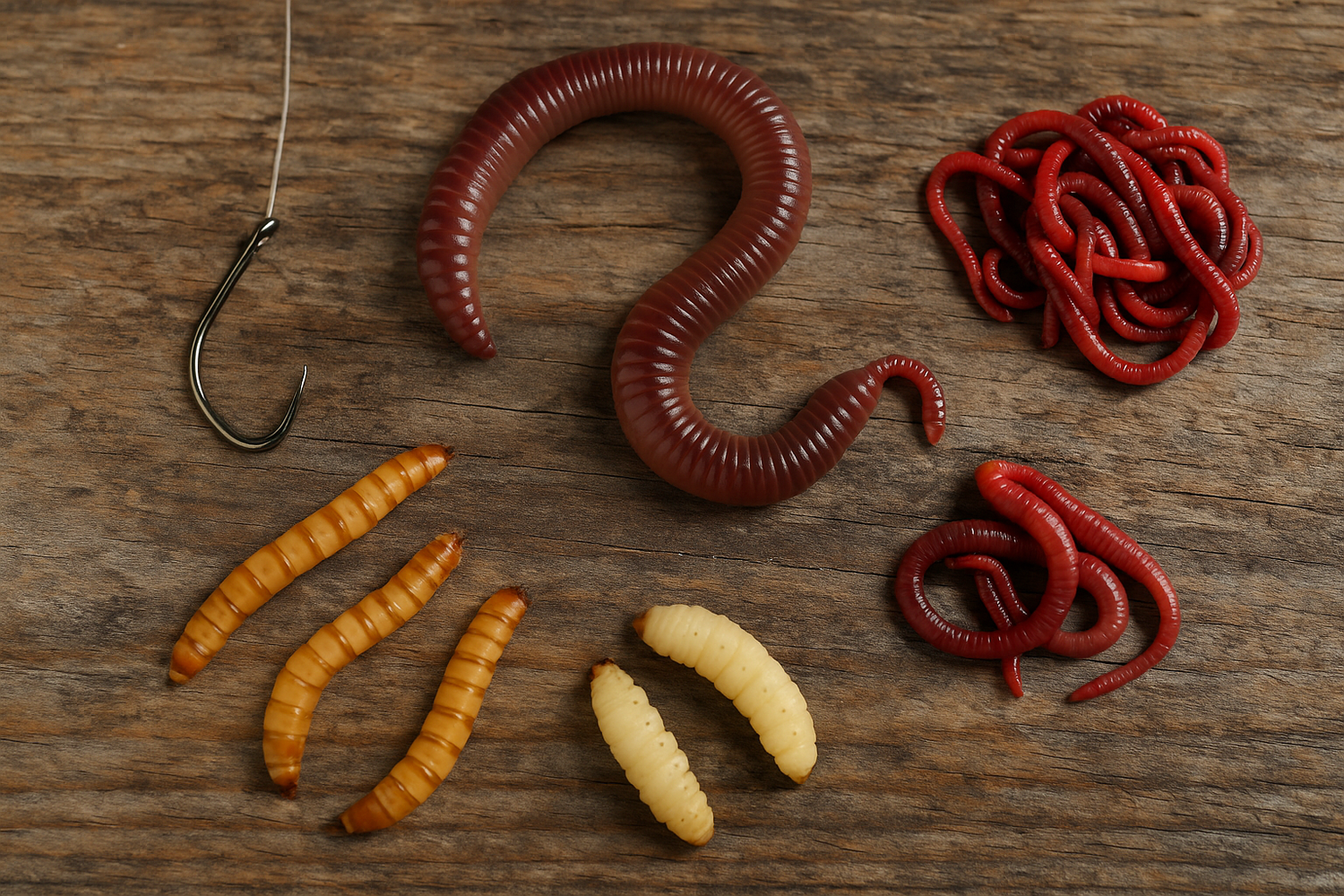Are you tired of coming home empty-handed after a long day of fishing? It's time to level up your game and reel in the success you've always dreamt of. And the secret weapon? The best worms for fishing. Yes, those slimy, wriggling worms are the key to hooking more bites and landing more fish.
But not all worms are created equal.
In this article, we’ll delve into the world of fishing worms and discover the top worm choices that are guaranteed to attract the attention of even the most elusive fish. From the classic nightcrawler to the lively red wiggler, we’ll explore each worm’s unique characteristics, benefits, and best fishing techniques to maximize your chances of success.
Whether you're a novice angler or an experienced bass fisherman, this comprehensive guide will give you everything you need to choose the right bait for different fishing situations.
Benefits of Using the Best Worms for Fishing
- Easily accessible and affordable – Find them in your yard or at any bait shop.
- Highly versatile – Effective in both freshwater and saltwater fishing.
- Natural movement and scent – Irresistible to a wide variety of fish.
- Simple to use – Thread them on a hook and start fishing

Types of Worms for Fishing
Nightcrawlers
Large and robust with a strong scent. These earthworms attract bass, catfish, and trout. Not all nightcrawlers are the same—some, like European Nightcrawlers, are more durable and easier to use.
Red Wigglers
Smaller than nightcrawlers but extremely active. Great for panfish and trout in freshwater.
Mealworms
Not true worms but beetle larvae. They are golden, soft, and excellent for ice fishing or catching bluegill, perch, and crappie.
Waxworms
Wax moth larvae that are soft and fatty. Ideal for trout, bass, walleye, and other hungry freshwater fish.

Best Worms for Freshwater Fishing?
Nightcrawlers
Perfect for largemouth bass, catfish, and trout. Use with Carolina rigs, Texas rigs, or by simply hooking them through the head.
European Nightcrawlers are especially effective:
- Easier to hook than red wigglers
- Stay alive longer
- Can tolerate brackish water
- Do not require refrigeration like Canadian nightcrawlers
If you want a full day of bites, grab a pack of live European Nightcrawlers and hit the water.
Red Wigglers
Ideal for bluegill, crappie, and perch. Fish them using a float rig or jighead for versatility in depth.
Mealworms
Popular for ice fishing. Thread onto small hooks and drop through the ice for trout, perch, and walleye.

Must Read : Types of Worms for Composting (and Why It’s Not as Simple as It Sounds)
Best Worms for Saltwater Fishing?
Bloodworms
Bright red with a powerful scent. Attracts striped bass, flounder, and redfish. Use bottom rigs or jigheads.
Sandworms
Found in sandy shorelines and estuaries. Excellent for surf fishing for flounder, surfperch, and bass.
Squid (Bonus Bait)
Though not a worm, squid is an effective saltwater bait. Use it whole or cut into strips for large fish like cod or bluefish.
Worms for Fishing – Choosing the Right Worm
When it comes to worms for fishing, choosing the right type makes all the difference between a slow day and a full catch bucket. The right worm should be lively, scented, and the right size for your target fish. Active worms create natural movement in the water, which attracts more bites.
How to Choose the Best Worm for Fishing
- Match the worm size to the fish: Larger worms like nightcrawlers attract catfish and bass, while smaller worms such as red wigglers work great for panfish or trout.
- Pick according to water type: Freshwater and saltwater conditions require different worm types; freshwater fish love earthworms, while saltwater anglers often prefer sandworms or bloodworms.
- Use live, healthy worms: Avoid dull or dry worms — fresh and moving bait always performs better.
| Worm Type | Best For | Pros | Cons |
|---|---|---|---|
| Nightcrawlers | Bass, Catfish | Big size, strong scent | Can be too large for small hooks |
| Red Wigglers | Panfish, Trout | Very active, easy to find | Small in size |
| Wax Worms | Trout, Crappie | Soft texture, high fat | Fragile in hot weather |
Wax Worms – A Specialized Bait Option
Wax worms are the larvae of wax moths and have become a favourite bait for anglers targeting finicky fish. Their soft, juicy texture and natural sweetness make them irresistible to trout, bluegill, and crappie.
Why Wax Worms Work So Well
- Strong natural scent that easily spreads underwater.
- Soft and plump texture perfect for fish with delicate bites.
- Excellent cold-water performance – ideal for ice fishing or early mornings.
Best Ways to Use Wax Worms
- Use a small hook (#8–#12) and thread one or two wax worms at a time.
- Combine wax worms with red wigglers for a double attraction effect.
- Ideal for float fishing or drop-shot rigs in calm waters.
Storage Tips
Keep wax worms refrigerated at around 50°F (10°C). Avoid moisture build-up to prevent mold. If you’re fishing for several days, store them in breathable containers with sawdust or bran.
Fishing Worms – Types and Best Uses
The term fishing worms covers all the worm species commonly used as bait. Each has unique characteristics suited for different fishing styles and conditions.
Common Types of Fishing Worms
- Red Wigglers – Great for beginners; lively and small, perfect for panfish and perch.
- Nightcrawlers – Big, tough, and full of scent; perfect for bass, walleye, and catfish.
- Mealworms – Ideal for trout and crappie; a good backup when worms aren’t available.
- Bloodworms – Saltwater favourite; bright red and rich in protein, irresistible to sea fish.
- Wax Worms – A delicate option for light rigs and finesse fishing.
Freshwater vs Saltwater Worms
| Worm Type | Water Type | Target Fish | Notes |
|---|---|---|---|
| Red Wigglers | Freshwater | Panfish, Trout | Easy to raise at home |
| Nightcrawlers | Freshwater | Bass, Catfish | Best during summer |
| Bloodworms | Saltwater | Flounder, Cod | Expensive but effective |
| Sandworms | Saltwater | Snapper, Sea bass | Ideal for surf casting |
Fishing for Worms – Harvesting, Buying & Caring
If you enjoy the full fishing experience, fishing for worms yourself can be fun and economical. You can collect, raise, or buy them depending on convenience.
Harvesting Worms Naturally
- Dig around damp soil, under logs, or compost piles early morning or after rain.
- Use a flashlight trick: shine a light after sunset — worms surface and can be easily collected.
- Avoid over-harvesting — take only what you need.
Buying Live Worms
If you prefer convenience, buy bait worms from trusted sellers who maintain healthy, active stock. Always check:
- Worms are plump, not dry or shriveled.
- Packed in breathable soil or bedding.
- Shipped in temperature-safe packaging.
Caring for Your Worms
- Keep them in a cool, dark, moist place.
- Do not overwater or expose to sunlight.
- Feed compost or organic scraps if you store for more than a few days.
Worms for Fishing Bait – Best Rigging & Presentation Tips
Knowing how to present worms for fishing bait can double your catch rate. Even the best worm won’t help if it’s hooked incorrectly.
How to Hook Worms Properly
- For nightcrawlers, thread 1–2 inches of the body onto the hook and leave the tail dangling for natural movement.
- For red wigglers, hook them once through the middle — they’ll wriggle more and attract attention.
- For wax worms, hook just under the head to avoid bursting.
Best Rigs for Worm Bait
- Float rig: Great for shallow waters and panfish.
- Bottom rig: Ideal for catfish and carp.
- Drop shot rig: Perfect for precise presentation in deeper waters.
- Split shot rig: Allows worms to move naturally in current.
Tips to Keep Worms Active
- Avoid handling with dry or hot hands.
- Keep them cool until just before casting.
- Refresh bait every 15–20 minutes if no bites occur.
Bait Worms – Storage & Longevity Secrets
Bait worms are your fishing investment — take care of them, and they’ll take care of your catch. Whether you’re storing at home or during a trip, proper care keeps them healthy and moving.
Storage at Home
- Use a ventilated container filled with slightly damp soil or bedding.
- Keep the temperature between 50–70°F (10–20°C).
- Add coffee grounds or vegetable scraps once a week.
On the Go
- Carry them in a small cooler or insulated box.
- Avoid direct sunlight — heat kills worms quickly.
- Add a damp paper towel to maintain humidity.
Bonus Tip
Sprinkle a few drops of worm bedding refresh solution or natural compost tea before leaving for your fishing trip. It keeps bait worms active and scented longer, increasing your catch chances.
How to Properly Hook a Worm?
Nightcrawlers & Red Wigglers
- Insert the hook through the head
- Thread along the body
- Let part dangle for lifelike motion
Mealworms & Waxworms
- Hook through the head
- For a larger presentation, stack multiple worms
- Always expose the hook point for a good hookset

Tips for Using Worms to Attract More Bites
- Use fresh worms – Active worms draw more attention.
- Experiment with presentation – Try floats, jigs, or bottom rigs.
- Keep it moving – Mimic natural motion by twitching the rod.
- Stay alert – Watch your line and be ready to set the hook quickly.
Want to know if your worm is according to the bait size? Checkout our quick guide:
Popular Fishing Techniques Using Worms
- Bottom Fishing: Let your bait sit on the lake or ocean floor. Great for catfish and flounder.
- Drift Fishing: Let your bait drift naturally in rivers or streams. Works well for trout and smallmouth bass.
- Drop Shotting: Suspend your bait off the bottom using a finesse rig. Ideal for targeting finicky bass and walleye.
Worm Fishing Gear and Accessories
- Rod & Reel: Medium action for freshwater; heavier setups for saltwater
- Fishing Line: Monofilament or fluorocarbon for freshwater; braided for saltwater
- Hooks: Match hook size to fish species
- Sinkers & Weights: Adjust for depth and current strength
Conclusion:
Using the right worms for the right conditions can transform your fishing game. From backyard ponds to brackish marshes, worms are versatile, effective, and beginner-friendly bait.
To catch more fish:
- Choose your worm wisely (hint: try European Nightcrawlers)
- Use proper rigging techniques
- Stay patient and observe fish behavior
With the right knowledge and gear, you’ll be reeling in trophy catches in no time.
Must Read : What To Feed Worms in 2025: The Complete Guide
Shop Live European Nightcrawlers Now
- Hardy in heat
- Perfect for freshwater and brackish fishing
- Loved by bass, panfish, and catfish
Curious why European Nightcrawlers are so popular? Read our deep dive here.



Leave a comment
All comments are moderated before being published.
This site is protected by hCaptcha and the hCaptcha Privacy Policy and Terms of Service apply.